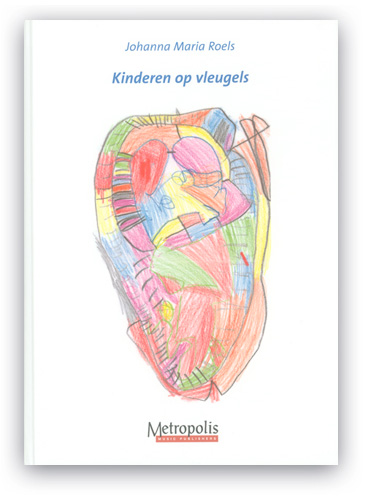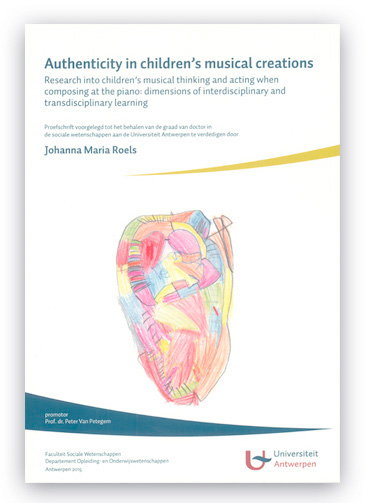Johanna Maria Roels

ROELS, J. M. (2002)
Children on Wings [Kinderen op vleugels]
Antwerpen: Metropolis Music Publishers. ISBN: 90-807186-1-0
This book is an illustration of the method with visual expression. It contains ca. 100 examples including drawings (visualized music terms) and compositions (transformed drawings and stories). Inclusive CD and English version.
The book is available from the author.
An Italian version ‘Bambini sulle ali’ was made by Dr. Dario De Cicco and can be accessed via the author.
More literature about the integration of visual expression can be found in these articles and books:
ROELS, J.M.
Children on Wings, The Creative Ability. Epta Piano Bulletin, 25 (2007-1) p.19. (language Dutch)
ROELS, J.M. & VAN PETEGEM, P. (2014).
The integration of visual expression in music education for children. British Journal of Music Education, 31 (3), 297-317.
DOI:10.1017/S0265051714000163.
ROELS, J.M. & VAN PETEGEM, P. (2016).
Transdisciplinary dimensions in the composing activities of children: transfer of strategies and transformation of knowledge. British Journal of Music Education, 33 (1), 81-99.
DOI:10.1017/S026505171500025X.
ROELS, J.M. (2017)
Children on Wings and 'Visual Composing': Dimensions of Interdisciplinary and Transdisciplinary Learning. In: Burnard, P., Ross, V., Minors, H.J., Powell, K., Dragovic, T., and Mackinlay, E. (Eds), Building Interdisciplinary and Intercultural Bridges: When Practice meets Research and Theory (section 2, 8). Cambridge: Bibacc.
(open access e-book on http://www.bibacc.org)
OH Y., ROELS J.M., VAN PETEGEM P. (2018)
Lifelong Music Learning for Sustainable Development. In: Leal Filho W., Mifsud M., Pace P. (eds), Handbook of Lifelong Learning for Sustainable Development. World Sustainability Series. Springer, Cham.
ROELS J.M. & VAN PETEGEM P. (2019)
Visual Concretization of Musical Concepts as Applied by Engineers: A Case Study. In: Conference proceedings 9th International Conference The Future of Education. Filodiritto Publishers.
Open access e-book pp. 469-474 on:
https://conference.pixel-online.net/FOE/files/foe/ed0009/FP/5646-MUS3836-FP-FOE9.pdf

ROELS, J.M. (2015)
Children on Wings 2. Analytical Practical Workbook
[Kinderen op Vleugels 2. Analytisch Praktisch Werkboek]
Antwerpen: Metropolis Music Publishers. ISBN: 979-0-3650-6995-8
This book contains ca.100 examples to compose or improvise at the piano and in general. Inclusive CD and DVD. This book is in line with the book Children on Wings and shows the long-term development of different pupils.
From the introduction
This publication contains a series of working models with accompanying exercises and compositions. In compiling the working models I became inspired by: inventions of my pupils, extra-musical data, traditional models and existing literature. The working models are intended for the piano (playing solo or in group) but equally lend themselves to other instruments – as shown in several examples. Some exercises can be used as etudes or repertoire pieces, others can be further elaborated. In explaining the compositions the symbol ☺ stands for the most important inventions of the pupils as well as for some music theoretical and -psychological analyses. Additional information can be found in the footnotes and annotations in the scores. The scores can also be used in addition to the current repertoire, separately from the working models. The idea that pupils not only compose with each other but also compose for each other, can have a refreshing effect on our educational thinking.


Jury: from right to left:
Prof. Dr. Pamela Burnard
University of Cambridge, UK
Dr. Johanna Maria Roels
Prof. Dr. Peter Van Petegem
University of Antwerp (promotor)
Dr. Luc Nijs
University of Ghent
Dr. Martine Huvenne
KASK and Conservatory / School of Arts Gent
Prof. Dr. Elke Struyf (chair)
University of Antwerp
Dr. Marlies De Munck
University of Antwerp
ROELS, J.M. (2015)
Doctoral thesis
Authenticity in children’s musical creations.
Research into children’s musical thinking and acting when composing at the piano: dimensions of interdisciplinary and transdisciplinary learning.
Antwerp: University (Gierle, Provo). ISBN: 9789057284960
(English version can be accessed via the author)
The doctoral thesis is based on 4 case studies which are published in international peer-reviewed ISI- journals in the field of music education.
ROELS, J.M. & VAN PETEGEM, P. (2014).
The integration of visual expression in music education for children. British Journal of Music Education, 31 (3), 297-317.
DOI:10.1017/S0265051714000163.
ROELS, J.M. & VAN PETEGEM, P. (2015).
Children composing and their visual-spatial approach to the keyboard. Music Education Research, 17 (4), 381-396.
DOI:10.1080/14613808.2014.930118.
ROELS, J.M. & VAN PETEGEM, P. (2016).
Transdisciplinary dimensions in the composing activities of children: transfer of strategies and transformation of knowledge. British Journal of Music Education. 33 (1/), 81-99.
DOI:10.1017/S026505171500025X.
ROELS, J.M. & VAN PETEGEM, P. (2016).
Children composing and the tonal idiom. International Journal of Music Education. 34(3), 324-339.
DOI: 10.1177/0255761415619067.
From the doctoral thesis
The wholeness of the child is a key element in the work of the founding fathers of child-centred teaching, such as Dalcroze (1921), Steiner (Stockmeyer, 1976), Orff (Warner, 1991) and Kodaly (Choksy, 1999). All of them point out the importance of understanding the learning content by means of sensory perception and hands-on activities. As a result of their work, music came to be linked to language, movement and play, and it was recognised that in children, these elements are still present as a unity. This unity is also very clearly apparent in the spontaneous singing or vocalisations of young children. Bjørkvold (1992) and Sundin (1998), among others, suggest that “spontaneous singing is an intrinsic part of a contextual whole, in which song, body movement, rhythm and word are totally interrelated, as one inseparable mode of expression”. Yet to what extent is this capacity for working from a synergy and synaesthesia of their talents and skills, which we find in young children, still used in their subsequent musical learning pathway?
The four case studies (chapters 2-5) reveal that interdisciplinary thinking and learning, and this is even more true for transdisciplinary thinking and learning, comes naturally to children and that they use a broader range of other disciplines than just the artistic. Consciously or not, children use different time scales; the smallest common multiple; algorithms; a fractal-related structure; a golden section proportion; chiasmi; linguistic analogies and chess-thinking; they distil their ideas to the smallest possible musical form; and they transpose dance patterns. This tells us something about their sensitivity to natural structuring (Skinner, 2010), their capacity to abstract from a broader range of non-musical experiences, and to transfer knowledge to new situations and transform this into new forms of expression. This brings out children’s artistic potential…
Publications
Publications about Johanna Maria Roels's work
De Baets T., de Vugt A. (2017).
In my life. Interview with Johanna Maria Roels. In: de Vugt A., Castelein T., De Baets T. (Eds.), Ticket to Ride. Practioners Research in Music Education, Chapt 4. Antwerpen/Apeldoorn: Garant. (language Dutch)
Tónsmíðar sem kennslutæki (Composition as a learning tool - language: Icelandic)